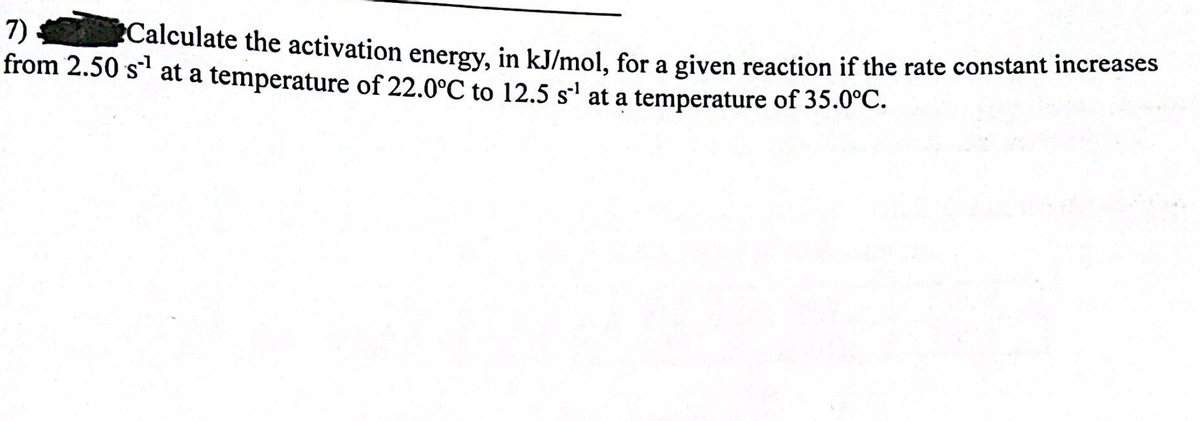8) true. proposed two-step mechanism is shown below. Circle all statements below that are Step 1 (slow): H₂(g) + 2NO(g) N₂O(g) + H₂O(g) Step 2 (fast): N₂O(g) + H₂(g) N₂(g) + H₂O(g) rate, cotla a The overall equation is 2H₂(g) + 2NO(g) b. N₂O(g) is an intermediate. c. N₂(g) is a catalyst. d. Both steps are bimolecular. e. The rate law for step 1 is rate = k[H₂][NO] f. The rate law for the overall reaction is rate = k[H₂][NO]² => N₂(g) + 2H₂O(g). 1 [H₂] [A10] ² → W[0₂0] [H 7) from 2.50 s¹ at a temperature of 22.0°C to 12.5 s¹ at a temperature of 35.0°C. Calculate the activation energy, in kJ/mol, for a given reaction if the rate constant increases
8) true. proposed two-step mechanism is shown below. Circle all statements below that are Step 1 (slow): H₂(g) + 2NO(g) N₂O(g) + H₂O(g) Step 2 (fast): N₂O(g) + H₂(g) N₂(g) + H₂O(g) rate, cotla a The overall equation is 2H₂(g) + 2NO(g) b. N₂O(g) is an intermediate. c. N₂(g) is a catalyst. d. Both steps are bimolecular. e. The rate law for step 1 is rate = k[H₂][NO] f. The rate law for the overall reaction is rate = k[H₂][NO]² => N₂(g) + 2H₂O(g). 1 [H₂] [A10] ² → W[0₂0] [H 7) from 2.50 s¹ at a temperature of 22.0°C to 12.5 s¹ at a temperature of 35.0°C. Calculate the activation energy, in kJ/mol, for a given reaction if the rate constant increases
Chemistry: Principles and Practice
3rd Edition
ISBN:9780534420123
Author:Daniel L. Reger, Scott R. Goode, David W. Ball, Edward Mercer
Publisher:Daniel L. Reger, Scott R. Goode, David W. Ball, Edward Mercer
Chapter13: Chemical Kinetics
Section: Chapter Questions
Problem 13.92QE
Related questions
Question
![8)
true.
proposed two-step mechanism is shown below. Circle all statements below that are
Step 1 (slow): H₂(g) + 2NO(g) N₂O(g) + H₂O(g)
Step 2 (fast): N₂O(g) + H₂(g) N₂(g) + H₂O(g)
rate,
cotla
a The overall equation is 2H₂(g) + 2NO(g)
b. N₂O(g) is an intermediate.
c. N₂(g) is a catalyst.
d. Both steps are bimolecular.
e.
The rate law for step 1 is rate = k[H₂][NO]
f. The rate law for the overall reaction is rate = k[H₂][NO]²
=>
N₂(g) + 2H₂O(g).
1 [H₂] [A10] ²
→
W[0₂0] [H](/v2/_next/image?url=https%3A%2F%2Fcontent.bartleby.com%2Fqna-images%2Fquestion%2F83200500-b6a2-4bc0-99d3-023f9c3e43df%2F27edc81b-9ef7-4901-af70-da25d0d43e0f%2F4pl9jes_processed.png&w=3840&q=75)
Transcribed Image Text:8)
true.
proposed two-step mechanism is shown below. Circle all statements below that are
Step 1 (slow): H₂(g) + 2NO(g) N₂O(g) + H₂O(g)
Step 2 (fast): N₂O(g) + H₂(g) N₂(g) + H₂O(g)
rate,
cotla
a The overall equation is 2H₂(g) + 2NO(g)
b. N₂O(g) is an intermediate.
c. N₂(g) is a catalyst.
d. Both steps are bimolecular.
e.
The rate law for step 1 is rate = k[H₂][NO]
f. The rate law for the overall reaction is rate = k[H₂][NO]²
=>
N₂(g) + 2H₂O(g).
1 [H₂] [A10] ²
→
W[0₂0] [H

Transcribed Image Text:7)
from 2.50 s¹ at a temperature of 22.0°C to 12.5 s¹ at a temperature of 35.0°C.
Calculate the activation energy, in kJ/mol, for a given reaction if the rate constant increases
Expert Solution
This question has been solved!
Explore an expertly crafted, step-by-step solution for a thorough understanding of key concepts.
Step by step
Solved in 2 steps with 1 images

Knowledge Booster
Learn more about
Need a deep-dive on the concept behind this application? Look no further. Learn more about this topic, chemistry and related others by exploring similar questions and additional content below.Recommended textbooks for you

Chemistry: Principles and Practice
Chemistry
ISBN:
9780534420123
Author:
Daniel L. Reger, Scott R. Goode, David W. Ball, Edward Mercer
Publisher:
Cengage Learning

Chemistry
Chemistry
ISBN:
9781305957404
Author:
Steven S. Zumdahl, Susan A. Zumdahl, Donald J. DeCoste
Publisher:
Cengage Learning


Chemistry: Principles and Practice
Chemistry
ISBN:
9780534420123
Author:
Daniel L. Reger, Scott R. Goode, David W. Ball, Edward Mercer
Publisher:
Cengage Learning

Chemistry
Chemistry
ISBN:
9781305957404
Author:
Steven S. Zumdahl, Susan A. Zumdahl, Donald J. DeCoste
Publisher:
Cengage Learning


Chemistry: An Atoms First Approach
Chemistry
ISBN:
9781305079243
Author:
Steven S. Zumdahl, Susan A. Zumdahl
Publisher:
Cengage Learning

Chemistry for Engineering Students
Chemistry
ISBN:
9781285199023
Author:
Lawrence S. Brown, Tom Holme
Publisher:
Cengage Learning

Chemistry: The Molecular Science
Chemistry
ISBN:
9781285199047
Author:
John W. Moore, Conrad L. Stanitski
Publisher:
Cengage Learning